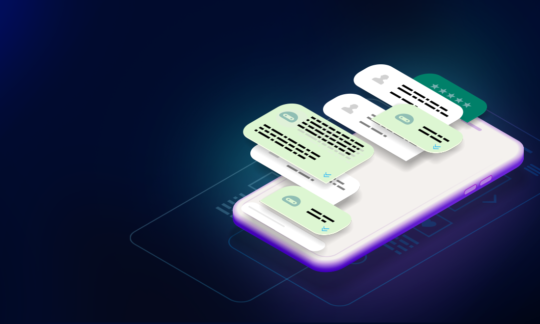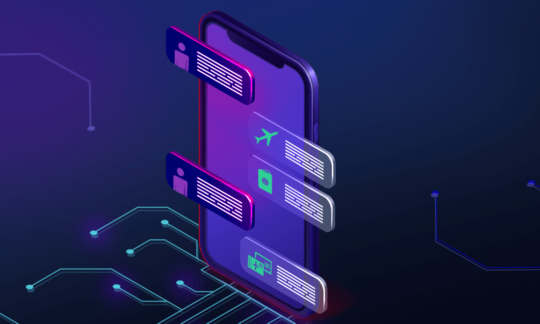Chatbots in the airline industry
Table of contents
As global crises are becoming the new norm, we look at how chatbots in the airline industry can help companies adapt and grow in an increasingly unpredictable world.
When discussing the recent emergence of conversational AI solutions, the COVID-19 pandemic gets often brought up — for obvious reasons. The prolonged lockdowns forced businesses worldwide to shift their services online. The initial outbreak heavily tested the limits of many leading communication channels.
Overnight, hotlines got overwhelmed by increased call volume, and websites were barely handling the traffic as the anxious population searched for reliable information. While healthcare facilities and governments suffered the most, it’s worth examining the particular kind of chaos that took over the airline industry.
Sudden lockdowns and strict health regulations implemented worldwide resulted in a record number of cancelled flights. Inevitably, soon, lots of customers were desperately trying to reschedule a ticket, get a refund or receive basic information.
It all quickly proved more than existing customer service systems could handle. According to the Airline Passenger Experience Association APEX, April 2020 saw over 25 thousand complaints filed to the US Department of Transportation. That’s 15 times above the norm. Seemingly out of nowhere, the aviation industry faced an unprecedented emergency in logistics and customer relations.
Airlines and chatbots, a match made in — wait for it — heavens.
While companies could not do much about the coronavirus, it was clear they must increase the processing capacity of their customer service. The industry immediately noticed that airlines which had adopted conversational AI before the pandemic performed best under the circumstances.
Chatbots (Virtual Assistants) are complex AI algorithms trained to understand our language. They can act like human agents and deal with customers’ requests most intuitively – through a conversation. They are usually deployed on companies’ websites or via popular messaging platforms like WhatsApp or Facebook Messenger.
When the coronavirus struck, airline AIs like AirAsia’s AVA, Iberia’s IBot and WestJet’s Juliet were ready to handle over 1000% increase in the number of queries. When most of the industry struggled with sheer call volumes, IBot and Juliet resolved almost 90% of cases without agents’ assistance.
So, other airlines soon followed. Some, like Lufthansa and KLM, simply adjusted their existing bots to new occurrences while United Airlines and India’s SpiceJet hurried to create their own conversational AIs.
Three years later, market research shows that the global AI in the aviation market is flourishing, booming in worth from merely $653.7 million in 2021 to almost $10 billion predicted for 2030. Virtual assistants have already proven they’re among AI’s most promising applications for this industry. It shouldn’t surprise anyone these are becoming increasingly popular with airlines, airports and booking sites.
But what makes chatbots so helpful?
Did you know that the LA Times once labelled being a customer service agent ‘the most stressful job in an airline?’ And that was even before the COVID-19 crisis emerged. Luckily, customer service chatbots are outstanding at reducing the workload and alleviating related stress issues.
Instead of directing each customer to an employee, companies can trust AIs to address many common queries with little to no supervision. They can provide information, book flights, sell services and solve other issues. Only when that proves to not be enough does a human agent get involved.
Chatbots and voicebots allow for
- relieving overloaded call centres
- reducing waiting times
- aiding customers faster
All this without compromising the quality of service! A resourceful agent who never sleeps, who works 24/7 and who can handle hundreds of conversations simultaneously makes a tremendous asset.
Conversational AI is particularly useful when 76% of customers expect brands to respond immediately. It proves invaluable during a crisis, such as a pandemic or workers’ strike – an increasingly probable occurrence these days.
Our guide can give you a better understanding of chatbots’ functionality and potential. But for now, let’s look at
The use cases of chatbots in aviation
Priorities may differ between branches of the industry. Some applications might be unique to airlines, airports or booking websites. The central premise, however, will always be to provide a smooth travelling experience and help customers solve potential issues with as little effort as possible.
Booking flights
Chatbots in the airline industry can quickly search and analyse databases, finding the perfect flight within seconds. No more scrolling through an innumerable list of options. All the user must do is describe where, when and how they wish to travel, and the chatbot will provide them with the closest available match. Few more messages to confirm the reservation and pay for the tickets, and voila! The customer is ready to start the journey.
Remote check-in
Well, almost ready. After all, passengers need to check in first.
Research shows fewer and fewer people enjoy doing so in person. Nowadays, merely 27% stand in a queue at the airport’s dedicated desk, while 50% prefer checking in online. COVID-19 ‘no touching’ policies only accelerated the tendency.
It’s hardly unexpected since remote solutions are known to be more comfortable and time efficient. They reduce labour, printing costs and waiting lines.
Moreover, checking in via a virtual assistant takes even less effort than using the airline’s website. Just a short conversation, and the chatbot will generate a boarding pass with a QR code.
Flight updates
As both life and Hollywood movies have taught us, things change in the aviation industry a lot, unexpectedly. Pandemics occur, weather shifts unpredictably, and if you’re truly out of luck, the plane you’re waiting for might get kidnapped by an evil John Malkovich or even attacked by venomous snakes.
The point is there are many reasons why a flight might be delayed, and it is in the airline’s best interest to keep passengers informed.
Chatbots can send update notifications and reminders or alert customers about an emergency. Unlike often ignored emails, virtual assistants have over a 90% open rate, making them an effective direct tool for reaching customers when it matters.
Locating lost luggage
Losing luggage might be one of the most stressful travelling incidents. As if surviving without important belongings wasn’t challenging enough, retrieving them required passengers to spend hours waiting on a helpline.
Chatbots are perfect for smoothing over such situations. They can offer real-time information on baggage location, fill reclaim forms and file for a refund, providing personalised and comprehensive service for the anxious customer. All this from within a familiar messaging app.
Claims and refunds
While we’re at filling and filing things, it would be worth noting how chatbots can facilitate these most mundane parts of the customer experience. Virtual assistants can conduct full interviews with claimants, generate complete submissions and pass them to human agents for review and further processing.
In the meantime, they can update clients on their claims’ status and inform them about companies’ policies or average processing time.
Navigating airports
Airports can be enormous, complex places full of busy, hungry people in a hurry. Chatbots can significantly ease their experience navigating these spaces.
They can quickly recommend the right restaurant to get that quick veggie meal they want or a shop where they can buy these perfumes that grandma loves. They can guide passengers to proper gates, help them find the restroom or a bus stop, provide them with maps and remind them when it’s time to board their plane.
Some airports use bots to help manage their parking spaces. This way, clients can learn about the fees, book a spot in advance or ask for help locating their vehicle.
Upselling offers
Virtual assistants are becoming increasingly effective at driving higher average order values. As early as 2019, chatbots were proven to increase sales by 67% on average, and AI technology becomes more efficient each year.
A chatbot can analyse your customers’ purchase history and recognise successful sales patterns. In other words, it can look at the current reservation and use its magical AI powers to determine what else the customer might need. It can suggest additional services, upgrades and upsell promotions.
To sum up
Chatbots in the airline industry can contribute to cutting costs, increasing customer satisfaction and saving time on both passengers’ and employees’ ends:
- Time efficient service: AI automation streamlines processes such as booking a flight, checking in or filing a lost luggage claim.
- Higher customer satisfaction: 24/7 availability, personalised service, and accessible information will make customers feel they’re fully taken care of.
- Better informed customers: Chatbots are an efficient, direct communication channel perfect for delivering flight updates, informing on luggage regulations and COVID-19 restrictions, or helping passengers find their way around an airport.
- Reducing labour and cutting costs: Automating so many tasks help companies reduce employees’ workload, redirect them to less mundane tasks, and optimise customer service efficiency.
- Scalability: No need to worry about overloaded helplines anymore. Virtual assistants can handle thousands of queries simultaneously.
Airlines and airport chatbots examples
Finnair
In 2018, the number of Chinese tourists visiting Nordic countries, mainly Finland, increased by 82% compared to the previous year. As Asian consumers do not easily trust unfamiliar services, Finnair found that most of them booked their flights through indirect retailers.
The airline decided to cut off the middleman but reaching such a specific customer base proved challenging. They’ve decided to create a chatbot account for WeChat — a popular Chinese messaging app. A virtual assistant named Finn allowed customers to modify their flights in locally relevant channels and opened new marketing opportunities for the company.
It could also book a ticket within the chat, help with flight status, answer frequently asked questions, and connect passengers to a human worker when necessary.
Aeroméxico
Aeroméxico’s Aerobot was the first airline chatbot to utilise the SETA WorldTracer system to help passengers find their missing baggage.
By simply talking to Aerobot via WhatsApp or Facebook Messenger, customers can quickly learn the location and the current status of their belongings, making the experience of retrieving the lost luggage as quick and low-stress as possible
Aerobot can also book flights, handle the check-in processes, issue a boarding pass, inform on flight status, and alert customers on flight recommendations and promotions.
Aéroports de Lyon
The international airport in Lyon uses an AI chatbot to provide passengers with assistance not only with flight-related issues but also with a range of services that the airport offers.
With the help of the chatbot, travellers can check in, find out their flight status, ask flight-related questions or even learn how to file a report for lost luggage. While waiting for their flights, customers can use the chatbot to navigate through shops and restaurants getting recommendations based on their needs and precise location in the airport.
Furthermore, automating access to parking information and the parking spaces booking system has increased the airport garage’s revenue by 40%.
It is only the beginning
Even though they’re already revolutionising businesses worldwide, AI technologies are still in their adolescence. Natural Language Understanding engines are only getting better and more accurate. While things already are good, they’re going to get even better.
The NLU system we’re proudly working on, SentiOne Automate, recently topped the intent recognition leaderboard, reaching a stunning 97,76% accuracy rate. It means that in almost 98 out of 100 messages, our AI interpreted the users’ intentions correctly and required no further clarification.
Algorithms no longer need clear, simple commands. They can already recognise a message’s context, figure out typos, and understand slang and dialect. What’s more, they’re capable of self-training to become even more proficient.
‘But I don’t know anything about AI programming…’
Luckily, you don’t need to. Chatbot developers provide intuitive, easy-to-understand management systems.
Here at SentiOne, we aim to ensure that our chatbot solutions are as accessible as possible. Even if you tremble at the sight of an average Excel sheet, you’ll likely succeed at creating a functional bot. That’s because we dedicated a lot of hard work to creating an intuitive, no-code bot builder. Whenever you want to teach your virtual assistant a new task, expand your business or deploy to a new market, you will be able to do so — without any programming experience!
Interested?
We suggest you reach out to us, so we can talk and possibly dispel any doubts you have.
Thanks to access to large datasets from social listening and a dedicated R&D team of engineers and linguists, we offer state-of-the-art solutions in conversational AI.
With SentiOne Automate, you can build your own chatbots using our intuitive interface (drag and drop blocks, automated testing, visual flow) and, thanks to our NLU models, guarantee high customer satisfaction. Furthermore, our solutions are fully compliant with the GDPR.
Learn more about the SentiOne Automate, or talk to us if you want to try it out.



